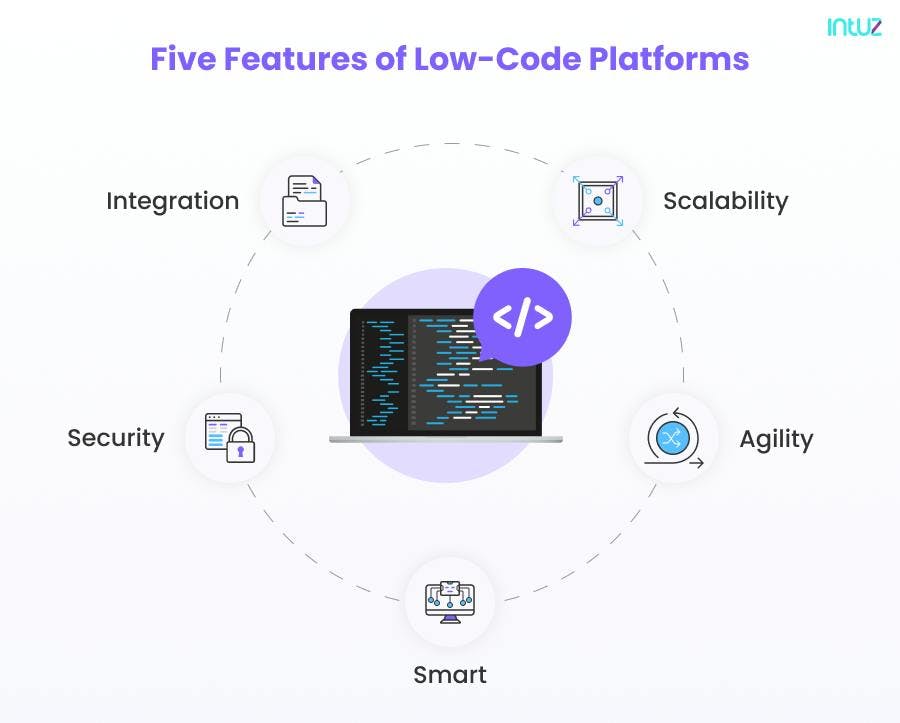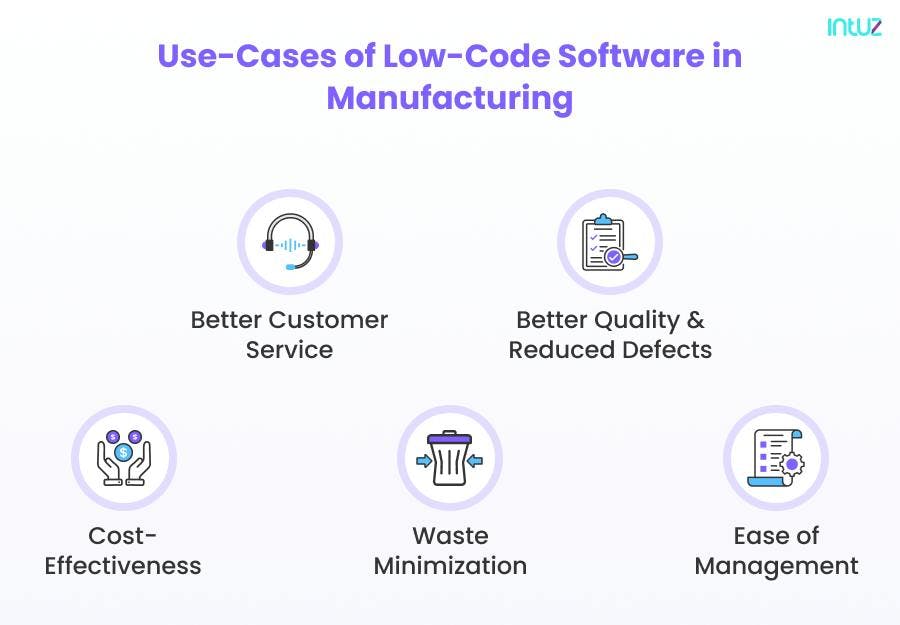Table of Content
Lean manufacturing is a production process focusing on minimizing waste within a manufacturing operation, resulting in reduced operating costs, lead times, and improved product quality. Overall, it is about terminating things that do not add value that customers would be willing to pay for.
It includes over-processing, inventory, overproduction, defects, motion, and waiting. Lead manufacturing enables businesses to deliver a product based on the customers' needs and fulfill their expectations. On the other hand, low code empowers companies that cannot quickly build apps to track manufacturing processes.
What is a low-code platform?
The goals of lean manufacturing include waste reduction and production process optimization. On the manufacturing floor or as part of the quality management process, manufacturers must provide quick and easy means for personnel to collect data and monitor systems.
The optimum answer is low-code or no-code software that enables producers to precisely digitize data collecting to monitor various components of the production process.
Employees can create effective apps that track production operations because of low code (like inventory, inspections, and supply chain). Without having to hire seasoned developers, lean manufacturing enables manufacturers to reduce costs significantly.
Citizen developers can easily upgrade the software in the event of market changes. Manufacturers can use low-code or no-code solutions to create practical applications that collect data on any mobile device.
Growth of low-code platforms
Over time, several low-code and no-code platforms have arisen. They are changing and democratizing businesses for the better. There is plenty of data to support its rapid and ongoing growth and the predicted expansion in the upcoming years.
The Fortune Business Insights projects that by 2028, the global market for low-code development platforms will increase from USD 13.89 billion to USD 94.75 billion. Organizations will use low-code or no-code platforms to create 70% of their new applications by 2025.
These facts suggest that the low-code and no-code sectors are developing and growing and will ultimately affect the future of technology in manufacturing. In fact, in the upcoming years, low-code platforms could essentially replace traditional app development practices.
Low-code for lean manufacturing: What is the point?
Low-code platforms aim to make it possible to quickly construct software applications without manually writing code. Therefore, these platforms let front-line employees or citizen developers create solutions to their challenges - even when they are not technologically inclined!
They can add custom features to these apps to resolve their unique problems. For many device types, including smartphones, tablets, and office browser apps, manufacturing professionals may create versatile and effective applications with the aid of low-code app platforms.
This ensures that manufacturers leverage subject-matter expertise to the fullest and that the production floor staff reclaims control. Manufacturing companies can speed up application development, fill in programming gaps, and improve floor automation by using visual interfaces with straightforward drag-and-drop functionalities.
Quality Control In The Age Of IoT Development Services: A Quick Glance
Learn MoreWhy opt for low code in lean manufacturing?
The popular Japanese automobile manufacturer Toyota first developed the concept of lean manufacturing. It set in motion real-time manufacturing combined with low inventory levels and automation - supervised by only a handful of professionals, such as floor managers and operations executives, to control the product quality. Here are the top seven benefits of low code in lean manufacturing:
1. Future-proof application logic
The software function blocks can be joined to form larger programs thanks to the graphical user interface. Many systems use if-this-then-that logic and event-based triggers to carry out business logic and monitor application interfaces when the end user interacts with the solutions.
2. Shorter development phase
Platforms for low code development shorten the build cycle and speed up the delivery of commercial apps. Because of this, many individuals, particularly those with considerable business understanding, may participate in app development.
For instance, industrial engineers can quickly develop apps for manufacturing applications using low-code application platforms to enhance shop floor operations.
3. No manual coding required
Software applications can be easily created using a low-code application development platform (LCDP), eliminating manual coding. On the other hand, a graphical user interface (GUI)—which frequently incorporates drag-and-drop components—can be used to change predefined software function blocks.
4. Continuous development
Unorganized production operations can result in chaos on the production floor. Low-code platforms assist in building apps that provide greater visibility to the manufacturer. It empowers them to calculate the time taken in each process segment.
What is more - low-code apps allow personalization, enabling manufacturers to track their floor workers' activities, location, and productivity. With such critical information, it becomes easier to achieve optimal productivity and performance.
5. Greater agility
Swift and efficient product delivery is made possible by lean manufacturing. Manufacturers can build mobile-friendly applications 10X faster than conventional app development techniques using low-code software. Low code offers easy and quick changes.
6. Smart factories
Manufacturers can use low-code platforms to access real-time data displaying machine output and pre-empting maintenance requirements that demand downtime. Since the IoT in manufacturing sector is experiencing a wave of digital transformation, it is not surprising to see the growth of smart factories.
Low-code platforms can support deploying processes that consolidate data silos by linking data from various systems into a single application. The technology helps predict real-time consumer demands and boosts efficiency by integrating all systems.
7. High automation
It automates different processes such as user instructions, job assignments, work guidelines, and so on. A low-code solution channelizes the entire production line and helps the floor managers stay up-to-date with incoming, delayed, and completed tasks.
Five features of low-code platforms
Manufacturing companies can no longer rely on legacy systems and processes to build and deliver products. Today's customers are looking for quicker deployments, and they understand the value of going digital. With legacy processes, building solutions for customers on time has many challenges. That is why using a low-code platform with the following features makes all the difference:

1. Integration
The ability of new IT products to be integrated into larger enterprise systems is a crucial criterion for software development initiatives. Fortunately, contemporary low-code applications are built to integrate with legacy platforms.
They offer function-specific apps that can be easily customized to meet an organization's needs. This is another aspect of integration. Such prebuilt applications can be used by businesses to support, speed up, or serve as the foundation for their digital transformation initiatives.
2. Scalability
Scalability is a crucial aspect of low-code and conventional software you cannot ignore. Apps may readily adapt to growing business objectives and shifting trends in the software industry using low-code development. Your low-code applications should be able to handle an increasing user base, whether it is 50 or 50 000.
3. Security
The majority of low-code applications available today are cloud-based, enabling you to keep all of your company data in data centers that are secure and protected.
Strong firewalls and intrusion prevention systems often protect the entire network, and geographically isolated data centers with best-in-class backups and clear disaster recovery procedures guarantee great availability and performance.
4. Agility
Low-code/no-code apps can be updated or changed more quickly and easily than apps created the conventional way. Different processes, such as job assignments, user instructions, work instructions, and so on, can be automated using low-code or no-code techniques.
The entire production process is streamlined. As a result, managers can keep track of tasks that are coming in, getting done, and/or getting delayed.
5. Smart
Low-code/no-code platforms can assist in the implementation of smart factories by reducing data silos by combining data from various systems into a single application, forecasting real-time customer demands even in the most uncertain situations, and increasing efficiency by fusing all the systems and processes.
Five use cases of low-code software in manufacturing
Leveraging low-code capabilities is good for businesses that want an application regardless of their in-house coding expertise. With low code, they can replace manual coding with a drag-and-drop editor to reduce the IoT app development time. Here are the five use cases of low-code software in manufacturing:

1. Better quality and reduced defects
Low code makes it easy to collaborate among teams. With lean manufacturing, each team can concentrate on quality because there is less emphasis on overproduction. Furthermore, because you are working with a small amount of inventory, any process flaws can usually be fixed with little collateral damage.
2. Better customer service
The primary goal of lean manufacturing is to increase value for the client. It is client-centric and addresses client needs at the right time. If a company's customers are content and satisfied, it can succeed. Customers will keep returning as long as a business can meet their needs and expectations, and the latter will prosper without hindrance.
3. Waste minimization
Minimizing waste is one of the core tenets of lean manufacturing. The quality and efficiency of the production process are increased with custom low-code solutions. Along with better value for the customer, waste is also reduced.
4. Ease of management
Lean manufacturing offers the benefit of using a smaller workforce even as the demand grows. Low code further decreases the workload by creating custom workflows and easy delegation of work. It is a bottom-up strategy that empowers employees to improve their productivity and ensures desired outcomes.
5. Cost-effectiveness
Platforms for low-code development provide workflow automation across platforms and seamless system interaction. As a result, it is less expensive to maintain IT teams who work on cross-platform development, integration, and testing.
Furthermore, low-code platforms lower the expense of recruiting development teams as existing employees can be trained into citizen developers.
The Ultimate Guide to Mobile App Development
Access the guideWhy do companies use lean manufacturing software?
Lean manufacturing software is used by businesses to increase profits by lowering waste and improving the customer experience. It gives them a competitive advantage.
Modern manufacturing companies use it to empower shop floor staff, improve equipment performance, and spur innovation in their production techniques. Instead of mass-producing goods, digital software makes it simpler to create production systems that meet client demand.
Teams and systems coordinate in real-time to address client requirements, enabling factories to be client-driven. Companies can boost efficiency in line with lean principles by eliminating the limitations of the conventional analog approach.
Software for lean manufacturing does not merely improve output. Processes for replenishing and reordering can also be controlled by it. Your company cannot adhere to lean principles if it uses Enterprise Resource Planning (ERP).
People frequently believe that material planning and production schedules are at odds with one another. Software, however, can quickly model hundreds of distinct scenarios and execute millions of complex calculations.
Lean management software implementation can help manufacturing companies in any industry sector. They can excel in all areas of planning, carrying out, and reporting functions.
It can assist operational and procurement teams in determining the quantities and qualities of raw materials required to meet demands. This ensures that the correct quantity is ordered and supplies do not end up as sources of surplus or lean waste. It combines lean production with ERP, giving you the best of both worlds.
Let's Build Low-Code IoT Solutions for Your Manufacturing Business!
Explore ServicesOver to you
Software application development is intricate and involves complicated procedures. However, the advent of low-code development platforms has lessened the difficulty and burden of creating applications on IT teams across industry verticals.
Today, software development is not just limited to the IT department. It has now become rapid and simple even for other organization teams.
The development process can be monitored and managed via an intuitive interface more efficiently than traditional coding methods. Additionally, the platform has built-in security features that help maintain overall system integrity.
Although governance and cultural shifts will continue to challenge such solutions, companies will use more advanced technologies to make low-code and citizen development a primary focus for the next few years.
Book a Free 45-minute Consultation with Our IoT Experts Today! Get a customized roadmap and strategies to leverage IoT for your lean manufacturing process.






